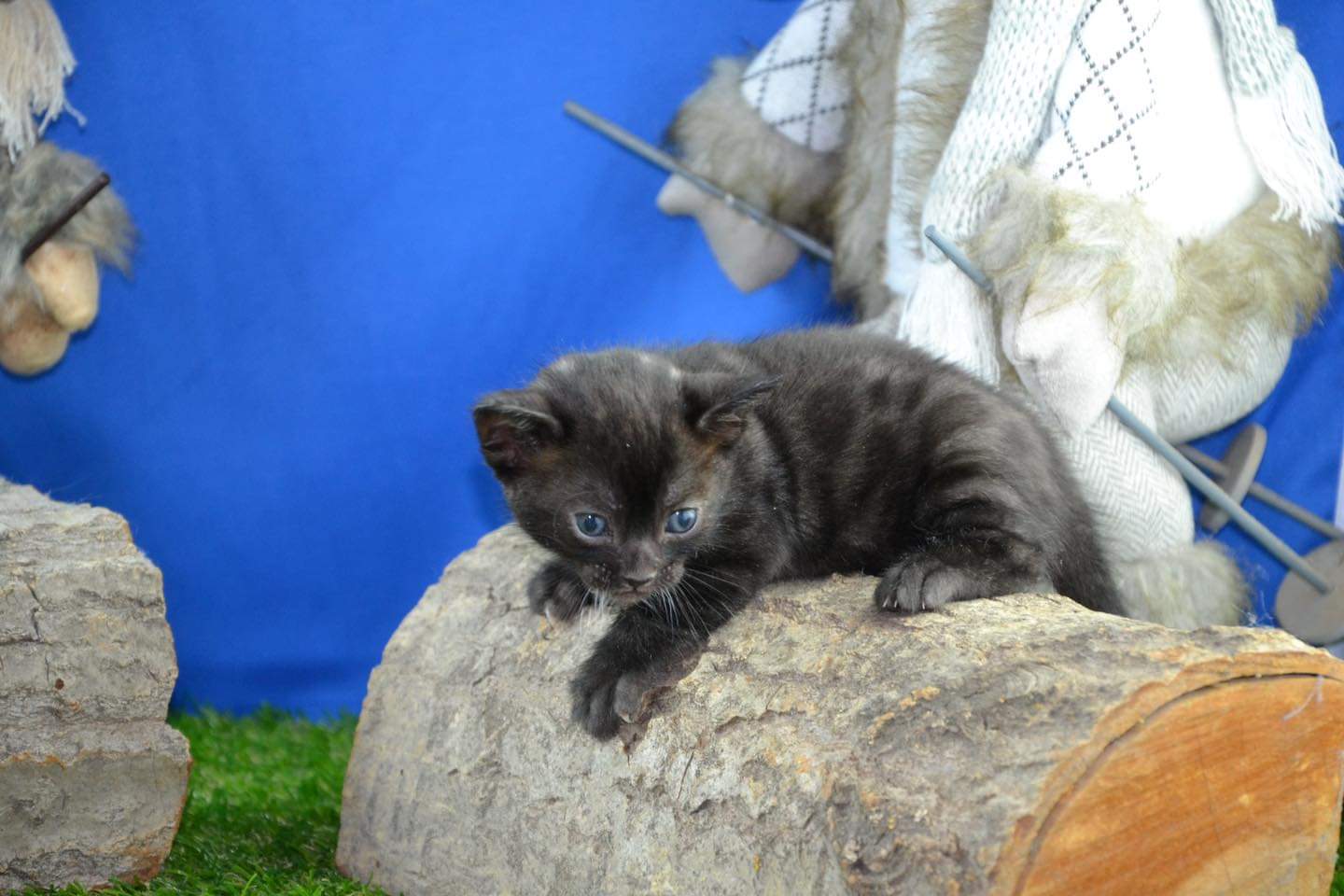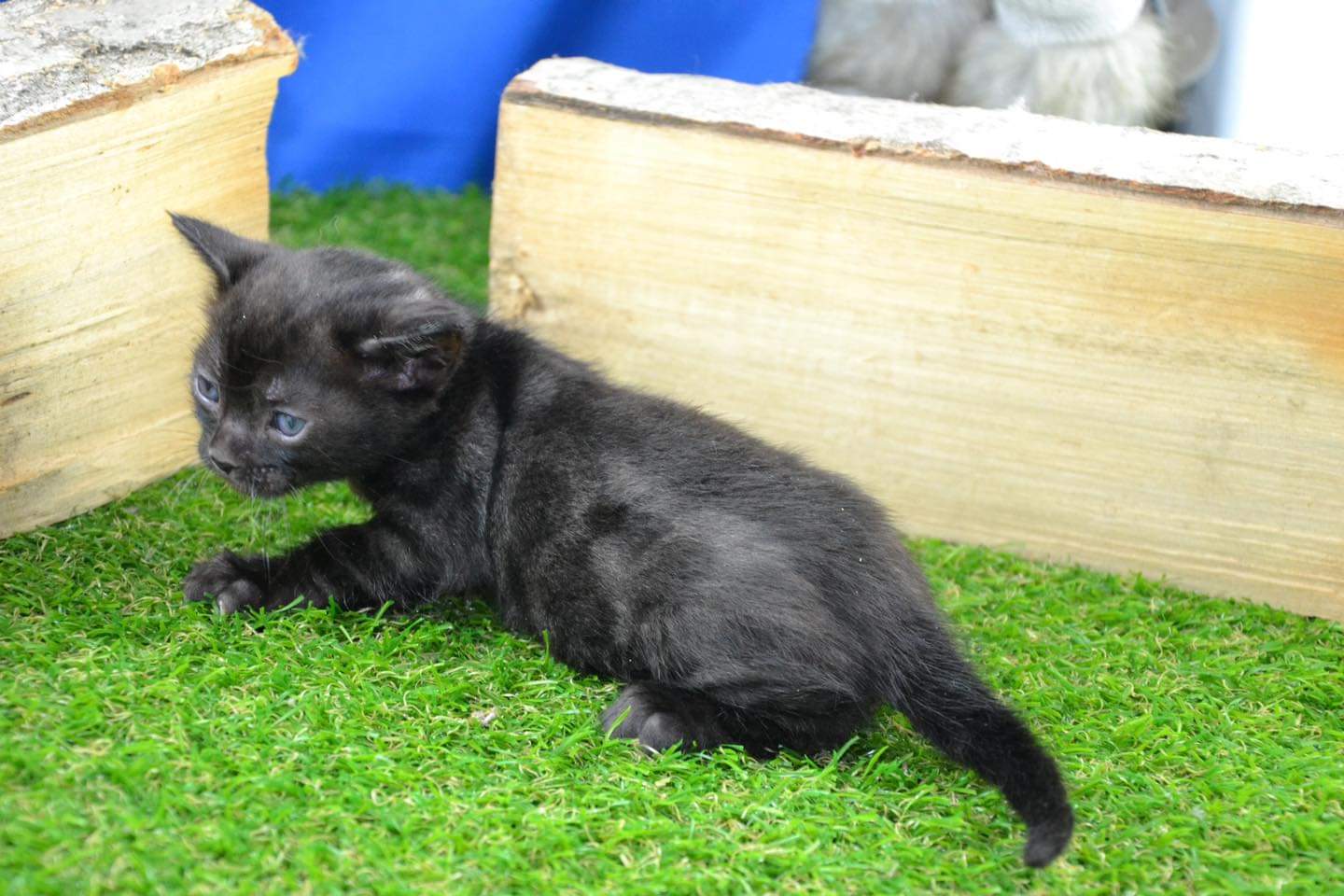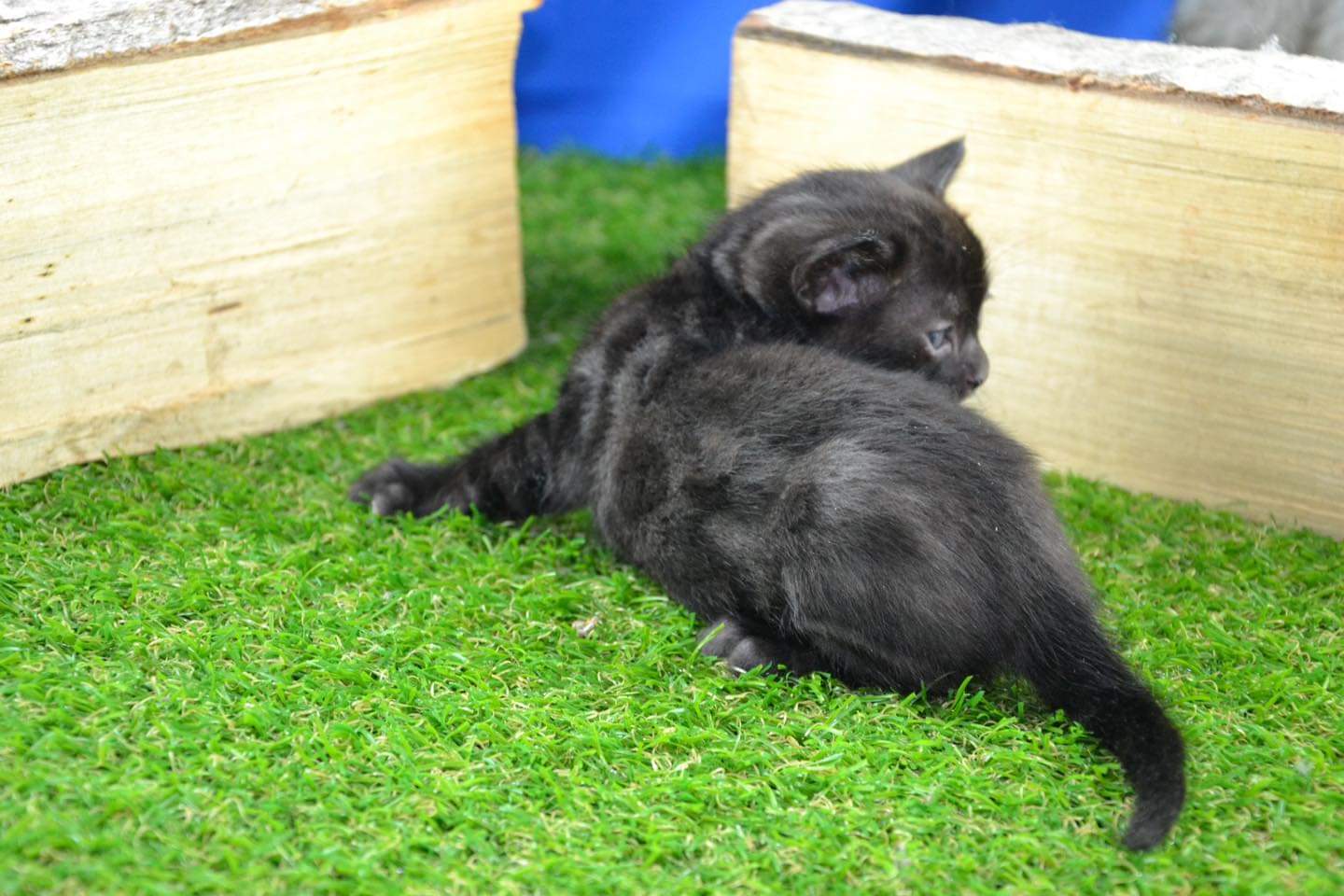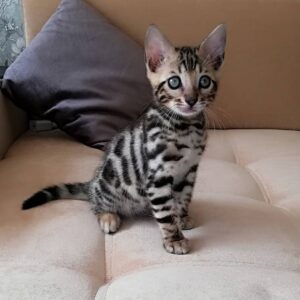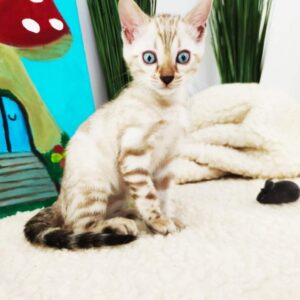Description
Melanistic Bengal kittens as well as an entire page dedicated to charcoal Bengal cat lovers!Although many people believe that there is one animal that is called a black panther, the term black panther is the common name for a black specimen (a melanistic variant) of any of several species of cats. The term Black Panther is referring to a melanistic (black) member of the Panthera family, or big cats. This means it could be a leopard, jaguar, lion or tiger. Melanistic, derived from melanin, is a dark colored skin and hair pigment. The term melanism does not mean that they are actually black, but that they are full of color solid. In cats, melanism results in the fur of the animal being very dark or black in color. Close examination of one of these black cats will show that the typical markings are still there, and are simply hidden by the surplus of the black pigment melanin. In many cases if you view a melanistic cat in bright sunlight, the markings of the animal can be faintly seen through the dark fur, especially at certain angles. Melanistic cats are commonly born into mixed litters along with normally colored siblings. Black panthers occur from a genetic mutation that cause them to produce more black pigment than orange-tan pigment, thus resulting in a largely black coloring. The same genetic mutation can occur in a Bengal litter. For this reason, while we do not breed for the melanistic gene, we do occasionally have a melanistic Bengal that pops up in one of our litters.
Melanistic Bengal kittens for sale
What Are Melanistic (black) Bengal Cats?
While the most common colors for bengal cats are brown and silver, there are many variations of colors that bengal cats can be.
One of the less common of these is black.
Black bengal cats are born as a result of melanism, a genetic mutation that creates excessive pigmentation leading to a black color.
Melanism is rare in bengals, however it still does occur as with many other domestic cat breeds.
Melanistic Bengal kittens for sale
What Causes Melanism in Bengal Cats?
Melanism in bengal cats is caused by a mutation of the agouti (ASIP) gene.
If a domestic cat has a non-agouti gene, then melanism may occur, otherwise the cat will not be melanistic.
This study breaks down the full variances in genetics that can lead to the different colors that bengal cats have.
The deletion of the agouti gene is recessive, meaning that a melanistic bengal cat requires both it’s parents to have the non-agouti recessive gene.
A bengal cat does not need to be black in order to possess the non-agouti gene, it only needs to be carrying this gene to be able to pass it down to it’s offspring.
Since the non-agouti gene is recessive, it may be masked by a dominant gene, meaning two non-melanistic bengal cats could potentially produce a melanistic bengal if both of them have the non-agouti gene.
However, because this gene is recessive, melanistic bengal cats are far less common than their brown, silver, and white colored bengal counterparts.
Melanistic Bengal kittens for sale
How Common Are Black Bengal Cats?
Overall, melanism is uncommon in domestic cats.
While around 30% of all domestic cats are black, not all of these cats are melanistic.
The distinction between a black cat and a melanistic cat is that black cats do not retain their dark color after bathing in the sun, meaning that their black fur is actually dark brown whereas melanistic cats will maintain their shade of black regardless.
Another distinction is that the color of melanistic cats will stay consistent from birth, whereas non-melanistic cats may change in color throughout their lives and become lighter or darker with time.
In wild cats, such as jaguars and panthers, melanism occurs in around 10% of the population, depending on their region and other environmental factors.
Natural selection is not a factor in domestic cats, so the ability of melanism to be passed down through generations primarily depends on the demand for melanistic bengal cats from cat owners.
While there is not substantial data on how common melanism is in bengals, it is safe to assume that < 10% of bengal cats in the world currently have melanism.
How Much Do Black Bengal Cats Cost?
Black bengal cats tend to cost more than brown bengal cats since they are less common.
On average, bengal kittens cost around $1,500 – $3,000, this is because breeding bengal cats is often a difficult, time-consuming occupation and in order to ethically breed bengals, the price needs to be above $1,000.
Black bengal kittens are towards to higher end of this range, usually at around $2,000 – $4,000 depending on the region and the filial generation of that bengal.What Are Melanistic (black) Bengal Cats? Posted on December 10, 2021 | by Admin While the most common colors for bengal cats are brown and silver, there are many variations of colors that bengal cats can be. One of the less common of these is black. Black bengal cats are born as a result of melanism, a genetic mutation that creates excessive pigmentation leading to a black color. Melanism is rare in bengals, however it still does occur as with many other domestic cat breeds. What Causes Melanism in Bengal Cats? Melanism in bengal cats is caused by a mutation of the agouti (ASIP) gene. If a domestic cat has a non-agouti gene, then melanism may occur, otherwise the cat will not be melanistic. This study breaks down the full variances in genetics that can lead to the different colors that bengal cats have. The deletion of the agouti gene is recessive, meaning that a melanistic bengal cat requires both it’s parents to have the non-agouti recessive gene. A bengal cat does not need to be black in order to possess the non-agouti gene, it only needs to be carrying this gene to be able to pass it down to it’s offspring. Since the non-agouti gene is recessive, it may be masked by a dominant gene, meaning two non-melanistic bengal cats could potentially produce a melanistic bengal if both of them have the non-agouti gene. However, because this gene is recessive, melanistic bengal cats are far less common than their brown, silver, and white colored bengal counterparts.
Where to Buy Melanistic Bengal Cats
If you are interested in becoming the owner of a melanistic bengal cat, there are several options to do so.
If bengal cats are legal to own in your country or state, then there likely are catteries or bengal cat breeders in your area who may have a melanistic bengal cat available.
Some known melanistic bengal cat breeders in the US are Paradiskittens and Traipse Charcoal Bengals.
As always, make sure to inquire about the health information of a bengal and do a background check on the breeder before welcoming a new cat to the family!
Melanistic Bengal Kittens
How to produce Melanistic/Black Bengal kittens?
Well, it is not easy to have a version of a Black Panther outdoor. However, it is also too delicate to produce such an amazing creature with wild physic. A shiny black coat, outstanding unique eyes, and a long lean body. We all are starving to know how Black Bengal kittens are produced.
As said before, the hero of the whole situation is the melanistic gene who is responsible for the color; Talking about the recessive gene of course. If both parents don’t have this stain, means the melanin, will not be able to transmit it. This means that the breeding will not be successful and the black in black appearance will be ruined. Because a Melanistic Bengal cat must hold two copies of the non-agouti gene, placed on its DNA, and should be derived from each parent. This pattern is genetically recognized as (a/a).
As for the parents, it is not necessary to have both gene copies previously. He may not be black; instead, he will be brown silver, snow, or blue. But no matter what the coat’s color is if he has received only one copy of that recessive gene. That should do!
And here we go, we know the process right? Let’s be sure now of the source and the origins of our Black Bengal kitten.
No one can deny that having a feline as beautiful as the black Bengal is such a big treasure. Because no matter what, this cat does really know its value. From its outside beauty to some special physical characteristics, till a strong and amazing personality. The Black Bengals are really unique and special compared to the other cats. After all, it is not easy to be a little version of an elegant and aloof black panther.
Now that you know that these cats do exist, what do you think? Did you make up your mind to pet them finally? Why not? Having a mini Black Panther cat wandering around your house is pretty cool. Yes! That shows that you are a person interested in the wild, and with a luxurious and fancy taste. Just try to get in the vibe and imagine having a Melanistic Bengal kitten cat staring at you, then watching it grow in front of you. that’s so heart warming.
Melanistic Bengal Kittens

